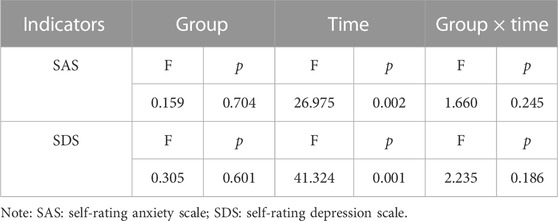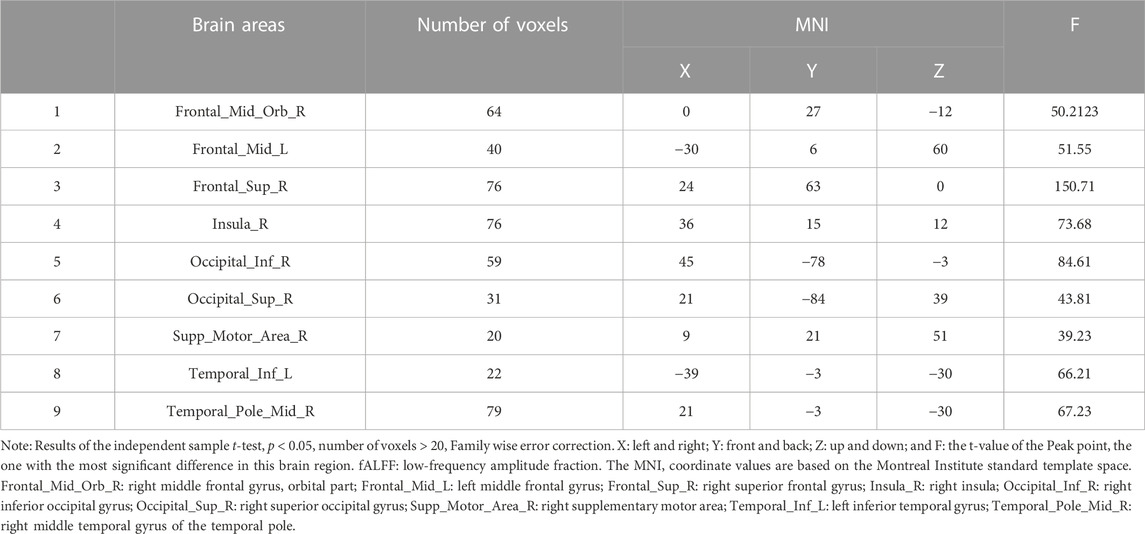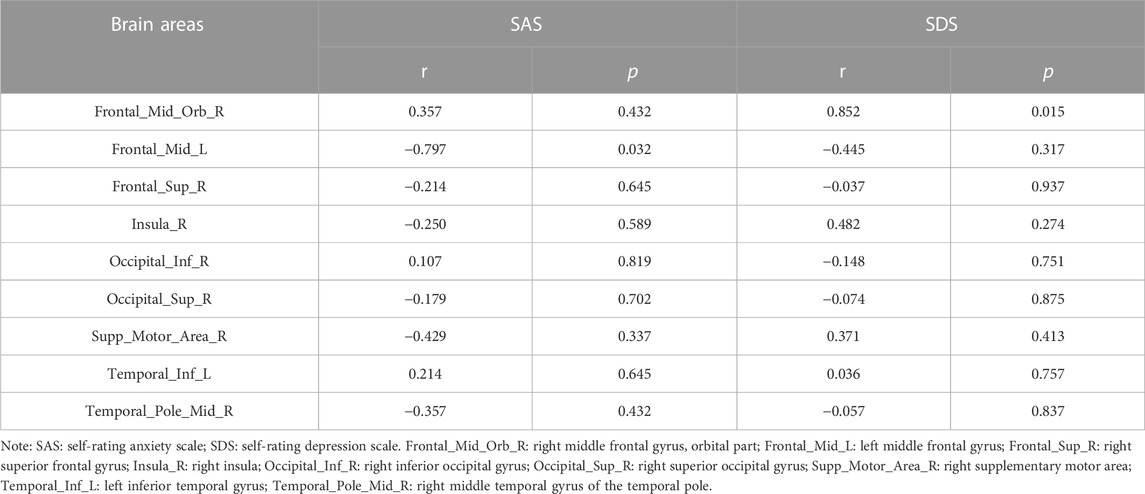- 1College of Physical Education and Sports Science, Beijing Normal University, Beijing, China
- 2Student Psychological Counseling and Service Center, Beijing Normal University, Beijing, China
- 3Department of PE, Peking University, Beijing, China
Objective: This pilot study aimed to explore the mechanism of the effects of Bafa Wubu of Tai Chi (BWTC) on anxiety and depression in college students using resting-state functional magnetic resonance imaging (RS-fMRI).
Methods: Eighteen college students (5 males and 13 females) with anxiety and depression met the study criteria and were randomly divided into an experimental group (aged 24.20 ± 4.07 years) and a control group (aged 22.50 ± 5.95). The experimental group received an eight-week BWTC intervention five times/week for 60 min/session. The control group maintained normal daily life without any exercise intervention. These students were assessed using RS-fMRI scans, the self-rating anxiety scale (SAS), and the self-rating depression scale (SDS). Spearman correlation analysis was used, and statistical significance was defined as a two-sided p-value of <0.05.
Results: After the intervention, the SAS and SDS scores of the BWTC group significantly reduced (p = 0.002; p = 0.001). Compared with the control group, the fALFF values of the right middle frontal gyrus, orbital part (Frontal_Mid_Orb_R) (p = 0.043), right inferior occipital gyrus (Occipital_Inf_R) (p = 0.003), and right middle temporal gyrus of the temporal pole (Temporal_Pole_Mid_R) (p = 0.003) in the BWTC group increased significantly; the fALFF values of the left middle frontal gyrus (Frontal_Mid_L) (p = 0.001) and right supplementary motor area (Supp_Motor_Area_R) (p = 0.010) in BWTC group decreased significantly. The fALFF values of Frontal_Mid_Orb_R were significantly positively correlated with the SDS score (r = 0.852, p = 0.015) and the fALFF values of Frontal_Mid_L were significantly negatively correlated with the SAS score (r = −0.797, p = 0.032).
Conclusion: In this pilot study with college students, BWTC alleviated anxiety and depression, potentially through modulating activity in the Frontal_Mid_L and Frontal_Mid_Orb_R, respectively.
1 Introduction
According to the theory of emerging adulthood, college students belong to a unique developmental phase spanning from late adolescence to adulthood (aged 18–29 years) (Arnett, 2000; Jin et al., 2023). College students face a wide range of changes in cognitive function (O’Rourke et al., 2020; Taylor and Snyder, 2021), emotional regulation, and behavior, which are linked to a greater possibility of engaging in risky behaviors e.g., Internet (or smartphone) addiction (Lu et al., 2020), alcohol abuse (Nelson and Padilla-Walker, 2013), alcohol-related sexual behavior (Litt et al., 2020; Persike et al., 2020; Edgerton and Keough, 2021), and developing mental health issues e.g., distorted eating habits, depression, and anxiety (Chi et al., 2020; Lin et al., 2020; Berge et al., 2021; Zhang et al., 2022) due to poor adjustment during this transitional period. Notably, anxiety and depression among college students are the most reported negative emotions considered as risk factors that affect physical (Fuller-Rowell et al., 2021) and mental health (Guastaferro and Bray, 2020; Halliburton et al., 2021), social function (Reed-Fitzke et al., 2021), academic performance (Gillen-O’Neel et al., 2021; Haikalis et al., 2022, and later career success/employment (Masdonati et al., 2022). Previous studies have indicated that 20%–30% of college students report different levels of anxiety and depression (Islam et al., 2020). The two intertwined negative emotions do not simply place a significant financial burden on individuals and their families but also challenge the national healthcare system (Simon et al., 1995). Therefore, there is an urgent need to identify effective strategies to prevent and treat these mental health issues.
Accumulating evidence indicates that non-pharmacological intervention (e.g., cognitive behavioral therapy, mindfulness/mediation, and mindful exercise) has beneficial effects on relieving anxiety and depressive symptoms (Neufeld et al., 2020; Chi et al., 2021; Pardos-Gascón et al., 2021; Pérez-Aranda et al., 2021). Compared to Western psychotherapy, Eastern medicine, especially traditional Chinese medicine (TCM), has received great attention over the past two decades. Within the theory of Chinese medicine, traditional Chinese mind-body exercise (e.g., Tai Chi, Baduanjin, and Wuqingxi) characterized by slow eye-hand and eye-foot coordinative movement, rhythmic deep breathing, and meditative state (Yeung et al., 2018) has become more popular worldwide (Zou et al., 2017; Zou et al., 2018). Notably, these beneficial features of Tai Chi are suitable for vulnerable populations, such as college students suffering from anxiety and depressive symptoms in school settings (Chang et al., 2021). For example, a seminar meta-analysis by Zhang et al. (2019) has concluded that Tai Chi is a cost-effective non-pharmacological approach for relieving anxiety and depressive symptoms among non-clinical individuals across different age groups including college students.
Notably, the potential neurobiological mechanisms underlying the alleviative effects of Tai Chi on depression and anxiety are still not fully understood. With emerging imaging techniques in recent years, exercise scientists have developed new tools to study changes in brain activity, structure, and function due to Tai Chi practice-induced changes (Yue et al., 2020a; Yue et al., 2020b; Chen et al., 2020; Yue et al., 2020c; Yu et al., 2021). Of note, previous imaging studies rarely used resting-state functional magnetic resonance imaging (RS-fMRI), which, as an emerging data acquisition tool, can measure functional connections and local neural activity in the brain in response to changing emotional states (Sparacia et al., 2019). This study used RS-fMRI to explore the effects of Bafa Wubu of Tai Chi (BWTC) on anxiety and depression in college students, and determine whether BWTC can effectively alleviate these negative emotions. This pilot study hypothesized that BWTC could decrease the levels of anxiety and depression in college students and that the neurological mechanism could be examined by fMRI.
2 Materials and methods
2.1 Participants
A total of 33 college students who reported different levels of anxiety and depression were recruited from the Student Psychological Counseling and Service Center of Beijing Normal University. After evaluation according to the inclusion and exclusion criteria, only 18 college students (five males and 13 females) were retained in the sample. The participants reported an age range of 18–30 years old. They voluntarily agreed to participate in this study and signed informed consent forms. The inclusion criteria were as follows: 1) a self-rating anxiety scale (SAS) (Zung, 1971) score of no less than 50, and 2) a self-rating depression scale (SDS) (Zung et al., 1965) score of no less than 53. The exclusion criteria were as follows: 1) major physical illness or serious mental illness, 2) taking medication, 3) movement disorders and serious joint damage, and 4) presence of metal objects in the body, such as pacemakers.
2.2 Study design
This pilot study involved college students. The participants were randomly assigned into two groups (1:1 ratio): the BWTC and control groups. The intervention lasted for 8 weeks. The research process included recruitment, screening, randomization, intervention, and follow-up. This study was approved by the Experimental Ethics Committee of the Department of Psychology of Beijing Normal University and conducted in compliance with the Declaration of Helsinki.
2.3 SAS and SDS
SAS was used to test students’ anxiety. SAS was tested for reliability with an intraclass correlation coefficient (ICC) of 0.908 (Zung, 1971). Participants were asked to rate 20 items on a scale of 1–4. The total score for each participant was then multiplied by 1.25. The anxiety score showed a positive correlation with anxiety tendency, and the anxiety of a participant was considered a critical value if his/her score reached 50 (Olatunji et al., 2006).
The SDS was used to test participants’ depression. SDS was tested for reliability with an intraclass correlation coefficient (ICC) of 0.937 (Zung et al., 1965). The main statistical indices, scoring criteria, and statistical methods employed by this scale were the same as those used by the anxiety self-rating scale. The depression score showed a positive correlation with depression tendency, and the depression of a participant was considered a critical value if his/her score reached 53 (Wittkamp et al., 2018).
2.4 Sample size calculation
SAS and SDS were set as coprimary outcomes and used for sample size calculation. The sample size was calculated based on the changes in the SAS and SDS between comparison groups with a significance level of 5% and a two-tailed critical region to detect an effect size of Cohen’s d = 0.50, with 80% power using G*Power V.3.1.9.6 software. Post-intervention, the mean scores of SAS and SDS in the control and intervention groups were (43.9 ± 5.6, 32.3 ± 4.5) and (53.6 ± 8.7, 39.2 ± 9.3) (Li et al., 2019), respectively, according to the published literature. Because the sample size calculation of SAS was smaller than that of SDS, the sample size calculation of SDS was selected. This would require 12 participants, increased to 18 to account for the failure to follow-up approximately 30% of participants, with nine participants assigned to each group.
2.5 Randomization and blinding
Eighteen participants were randomized into groups using SPSS 21.0 software. The steps were as follows: 1) Encode 18 participants 1–18, 2) set the random number of seeds (0–2000000), 3) generate random numbers (ranged 0–1), 4) sort and group (using the visual discretization method, the number of segmentation points is 1, the width is 50%, and the cut point value is 0.318), and 5) the results of the random grouping were obtained. Blindfolding the participants was difficult because of the characteristics of the intervention measures. Hence, only indicator testers and data analysts were blindfolded.
2.6 Intervention plans
The college students in the intervention group received a 1-h BWTC exercise intervention five times a week for eight weeks. The intervention involved 10 min of warm-up activities, 40 min of practice, and 10 min of closing activities. The intervention emphasized not only the postures but also the combination of body, breath, and mind, given that BWTC requires one to “build his/her body,” “convey his/her breaths,” and “use his/her mind” (Lyu, 2018). Participants in the control group went on with their daily lives as usual and did not perform regular physical activities. None of the participants were taking psychotropic or other drugs with similar effects during the study.
2.7 Data acquisition
Data were collected at the Magnetic Resonance Laboratory of the Magnetic Resonance Imaging Research Center of Peking University. A Siemens 3tPrisma MRI scanner was used for the data collection. The MRI real radiology department was equipped with an eight-channel phased array head MRI system, which was also used for the acquisition. Functional imaging was performed using gradient echo planar imaging sequences. The scanning parameters obtained included repetition time (TR) = 2,000 ms, echo time (TE) = 30 ms, field of view (FOV) = 220 mm × 220 mm, flip angle (flip angle) = 90°C, matrix = 64 × 64, number of layers = 36, layer thickness = 4 mm, and scan time = 480 s. To mitigate noise from the scanner, each participant was given earplugs before the test. At the beginning of the test, the participants lay flat on the scanner with their heads fixed. They were required to keep their heads and bodies still and remain in an awake and relaxed state throughout the test.
2.8 Data processing
The data were analyzed and processed on the Matlab13b platform using the Data Processing Assistant for RS-fMRI software. The data were processed as follows: 1) data format conversion: the data format was converted from Digital Imaging and Communications in Medicine (DICOM) to the Neuroimaging Informatics Technology Initiative (NIfTI); 2) removal: the data for the first 10 time points were removed (the test involved 240 time points, and only 230 time points were used as experimental data); 3) slice timing: the middle of the total number of layers was set; 4) realign: according to the head movement correction curve, participants showing a U-turn movement in the x-, y-, and z-axes with translations greater than 1 mm and rotations greater than 1°C were excluded; 5) normalize: the inter-individual differences were reduced to an MNI ERI template through spatial normalization. The voxel resampling was 3 mm × 3 mm × 3 mm; 6) smooth: the Gaussian smoothing kernel with a full width at half maximum (FWHM) of 6 mm was used to smoothen the noise reduction; 7) detrend: the temperature increases due to the work of the machine or the participants were adapted, and the accumulated data collection time showed a linear trend; and 8) calculate the ratio of low-frequency amplitude fraction (fALFF): the root of the power spectrum of the 0.01 Hz–0.08 Hz signal was used to obtain the ALFF value, and the ratio of the amplitude sum in the low-frequency band to the amplitude sum of the whole frequency band was used to obtain the fALFF value.
2.9 Statistical analysis
The SPSS 21.0 statistical software was used for the data processing. Continuous variables are described as mean ± standard deviation (SD) for normal distributions or median for non-normal distributions, and categorical variables are described as frequency. The baseline data mainly describe the characteristics of the participants. Two-way repeated measures ANOVA was used to analyze the effects of anxiety and depression before and after the intervention in the two groups and the interaction between them. Statistical parametric mapping (SPM12) software was used for statistical analysis. The fALFF values of different brain regions were extracted and post hoc tests were performed. Age, sex, height, and weight were used as covariates, and the Bonferroni correction was used. Paired-sample t-tests were used for within-group comparisons, and independent-sample t-tests were used for between-group comparisons. Within-group comparisons were performed with Family Wise Error (FWE) correction, and the union of one-sample t-test results of the two groups were used as the range of brain functional map comparisons (p < 0.05, number of voxels > 20). Comparisons between groups were performed with the FWE correction, and brain regions with p < 0.05 and the number of voxels > 20 were defined as statistically different regions. We used xjview and BrainNet Viewer software to present the results. Spearman correlation analysis was used to analyze the correlation between changes in brain area parameters and SAS and SDS scores. Statistical significance was defined as a two-sided p-value of <0.05.
3 Results
3.1 Baseline sample characteristics
Before the intervention, no significant differences were observed between the two groups in terms of age (p = 0.483), sex (p = 0.736), height (p = 0.475), weight (p = 0.500), SAS score (p = 0.604), or SDS (p = 0.490) (Table 1).
3.2 Comparison of SAS and SDS scores in the two groups
Compared to the change in SAS, there was no interaction between group and time (F = 1.660, p = 0.245). The results showed that the change in SAS scores had a main effect of time (F = 26.975, p = 0.002). Compared with before intervention, SAS in the BWTC group was significantly reduced after intervention (56.94 ± 9.23 vs. 41.60 ± 8.85, p < 0.01), while there was no significant difference in the control group (p > 0.05). Compared to the change in SDS, there was no interaction between group and time (F = 2.235, p = 0.186). The results showed that the change in SDS had a main effect of time (F = 41.324, p = 0.001). Compared with before intervention, SDS in the BWTC group was significantly reduced after intervention (69.29 ± 12.16 vs. 43.39 ± 10.17, p < 0.01), while there was no significant difference in the control group (p > 0.05). The results are presented in Tables 2, 3.
3.3 Comparison of RS-fMRI between the two groups after the intervention
After the intervention, the interaction between the fALFF values in the right middle frontal gyrus, orbital part (Frontal_Mid_Orb_R), left middle frontal gyrus (Frontal_Mid_L), right superior frontal gyrus (Frontal_Sup_R), right inferior occipital gyrus (Occipital_Inf_R), right superior occipital gyrus (Occipital_Sup_R), right supplementary motor area (Supp_Motor_Area_R), left inferior temporal gyrus (Temporal_Inf_L), and right middle temporal gyrus of the temporal pole (Temporal_Pole_Mid_R) of the two groups changed significantly. The results are shown in Table 4; Figures 1, 2.
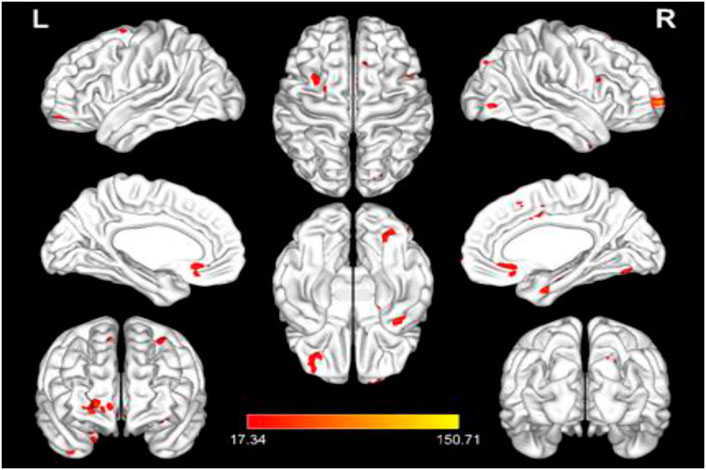
FIGURE 1. 3D plot of the significant interaction of fALFF values. Note: The red bars represent those brain regions with significant interactions, and the statistical threshold was set to p < 0.001 and the number of voxels was > 20. L: left; R: right; and fALFF: low-frequency amplitude fraction.
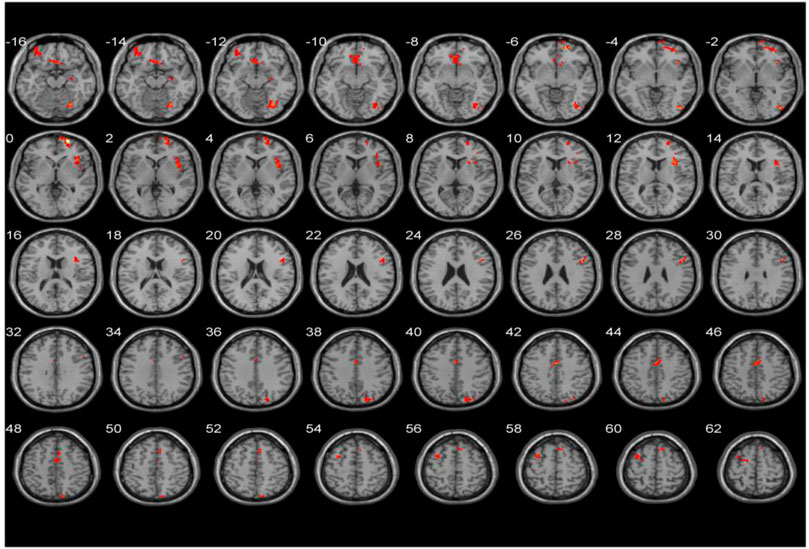
FIGURE 2. Significant plane diagram of the interaction effect of fALFF values. Note: The color bar represents the brain area with significant interaction, the statistical threshold was set to p < 0.001, and the number of voxels was > 20. fALFF: low-frequency amplitude fraction.
To further analyze the differences between the groups before and after the intervention in the same brain region, the fALFF values of different brain regions were extracted for post hoc analysis. After the intervention, compared with the control group, the fALFF values of the Frontal_Mid_Orb_R (p = 0.043), Occipital_Inf_R (p = 0.003), and Temporal_Pole_Mid_R (p = 0.003) in the BWTC group increased significantly, indicating that the local activity of the corresponding brain regions was enhanced, while the fALFF values of Frontal_Mid_L (p = 0.001) and Supp_Motor_Area_R (p = 0.010) in the BWTC group decreased significantly, indicating that the local activity of the corresponding brain regions was weakened. The results are shown in Figure 3.
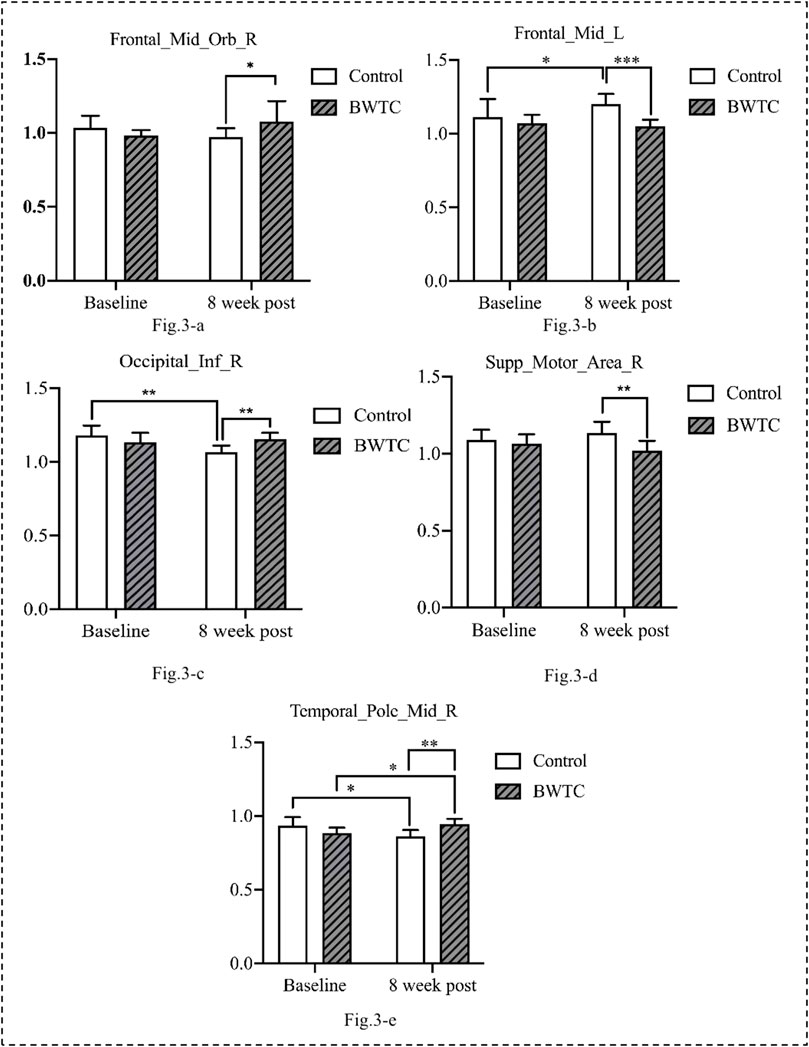
FIGURE 3. The differences between the groups before and after the intervention in the same brain region.
To further explore the potential correlation between anxiety and depression and local brain activity after the intervention, the correlation coefficients of fALFF values and SAS-SDS scores were calculated using Spearman correlation analysis. The fALFF values of Frontal_Mid_Orb_R were significantly positively correlated with the SDS score (r = 0.852, p = 0.015) and the fALFF values of Frontal_Mid_L were significantly negatively correlated with the SAS score (r = −0.797, p = 0.032) (Table 5).
4 Discussion
To the best of our knowledge, this study is the first to explore the mechanism underlying the effects of BWTC on anxiety and depression in college students using RS-fMRI. After eight weeks of BWTC, the participants in the BWTC group showed significant improvements in anxiety and depression, whereas those in the control group showed no significant changes. The RS-fMRI results showed that, compared with the control group, the Frontal_Mid_Orb_R, Occipital_Inf_R, and Temporal_Pole_Mid_R in the BWTC group were enhanced, and Frontal_Mid_L and Supp_Motor_Area_R in the BWTC group were weakened after the intervention. This study further explored the potential correlation between anxiety, depression, and local brain activity after the intervention. Frontal_Mid_Orb_R was significantly positively correlated with depression and Frontal_Mid_L had a significant negative correlation with anxiety.
Yang et al. (2016) found that depression and anxiety can be alleviated by modulating the functional connectivity between the interior and insular cortices of the dorsal cingulate gyrus, suggesting that the regulation of anxiety and depression is closely related to the functional connectivity of the brain. In other words, anxiety and depression can be alleviated by improving the functional connectivity of the local brain regions. Gold et al. (2015) identified the insula, thalamus, striatum, cingulate cortex, and amygdala as brain regions associated with anxiety, whereas Etkin et al. (2011) identified the insula, paracingulate cortex, and medial prefrontal cortex as brain regions associated with emotional engagement and processing, especially fear and anxiety. The insula, prefrontal cortex, anterior cingulate cortex, and amygdala play important roles in the development, processing, and regulation of depression and anxiety. Therefore, BWTC exercise improves anxiety and depression mainly by modulating the functional connectivity and neural activity of related brain regions. This study found that BWTC may relieve anxiety and depression by regulating neural activity in the Frontal_Mid_L and Frontal_Mid_Orb_R, respectively.
This study also analyzed the reasons why BWTC effectively alleviated anxiety and depression among college students. During practice, participants in the BWTC group were required to cooperate closely with their minds. Previous studies have shown that the mind completes information transmission through bioelectricity accompanied by neural and humoral regulation, generates neuronal excitement, and places the cerebral cortex in a special state of excitation, thereby regulating psychological and physiological activities (Ray, 2004; Hassan et al., 2019; Tang et al., 2019). This study attributes this effect to the emphasis of BWTC on the oneness of the body and mind, which stimulated the brain regions of the participants to a certain extent. Such stimulation generates bioelectrical signals that lead to excitation and biochemical reactions, such as neurotransmitters and hormones, and activates key brain regions for emotion regulation, such as Frontal_Mid_L and Frontal_Mid_Orb_R. The brain network connections and mechanisms of these brain regions are optimized, thereby alleviating anxiety and depression in college students. BWTC is often accompanied by relaxing and soothing music, which can stimulate the auditory nervous system, relax tense nerves, and subsequently alleviate anxiety and depression (Petrovsky et al., 2015). A meta-analysis of 44 original studies by Song found that aerobic exercise may have a better effect on anxiety and stress, whereas traditional Chinese exercise may have a better effect on stress. This study found that BWTC might improve anxiety and depression.
This pilot study had several limitations. First, additional physical activities of the participants throughout the study could not be easily monitored. Second, the sample size was relatively small and the intervention was delivered over a relatively short period. Future studies should employ larger samples and longer in-depth exercise durations to confirm the findings of this study.
5 Conclusion
In this pilot study with college students, BWTC had the potential to alleviate anxiety and depression in college students by regulating neural activity in Frontal_Mid_L and Frontal_Mid_Orb_R, respectively.
Data availability statement
The raw data supporting the conclusion of this article will be made available by the authors, without undue reservation.
Ethics statement
The studies involving human participants were reviewed and approved by the Experimental Ethics Committee of the Department of Psychology of Beijing Normal University and was conducted in compliance with the Declaration of Helsinki. The patients/participants provided their written informed consent to participate in this study.
Author contributions
SL and JZ conceived and designed the study protocol. The individual interviews were conducted by TG, ZS, YL, JZ, QW, and MC. JZ and TG analyzed the data. JZ, FP, QW, MC, ZC, and YL guided and supervised the Tai Chi training. JZ and SL contributed to the writing and reading of the manuscript. All authors gave their final approval and agreed to be accountable for all aspects of the work to ensure its integrity and accuracy.
Funding
This work is financially supported by “the Fundamental Research Funds for the Central Universities (2021NTSS01)” of JZ.
Acknowledgments
The authors are most grateful to the psychologists of the Student Psychological Counseling and Service Center of Beijing Normal University and the Department of PE of Peking University. We also thank all the participants in this study.
Conflict of interest
The authors declare that the research was conducted in the absence of any commercial or financial relationships that could be construed as a potential conflict of interest.
Publisher’s note
All claims expressed in this article are solely those of the authors and do not necessarily represent those of their affiliated organizations, or those of the publisher, the editors and the reviewers. Any product that may be evaluated in this article, or claim that may be made by its manufacturer, is not guaranteed or endorsed by the publisher.
References
Arnett J. J. (2000). Emerging adulthood: A theory of development from the late teens through the twenties. Am. Psychol. 55, 469–480. doi:10.1037/0003-066X.55.5.469
Berge J. M., Larson N., Neumark-Sztainer D. (2021). Emerging adults and social distancing during COVID-19: Who was more likely to follow guidelines and what were the correlates with well-being and weight-related behaviors? Emerg. Adulthood. 9, 670–678. doi:10.1177/21676968211051482
Chang J. J., Ji Y., Li Y. H., Pan H. F., Su P. Y. (2021). Prevalence of anxiety symptom and depressive symptom among college students during COVID-19 pandemic: A meta-analysis. J. Affect. Disord. 292, 242–254. doi:10.1016/j.jad.2021.05.109
Chen L. Z., Yuan X., Zhang Y., Zhang S., Zou L., Yang L., et al. (2020). Brain functional specialization is enhanced among tai chi chuan practitioners. Arch. Phys. Med. Rehabil. 101, 1176–1182. doi:10.1016/j.apmr.2020.02.005
Chi X., Becker B., Yu Q., Willeit P., Jiao C., Huang L., et al. (2020). Prevalence and psychosocial correlates of mental health outcomes among Chinese college students during the coronavirus disease (COVID-19) pandemic. Front. Psychiatry. 11, 803. doi:10.3389/fpsyt.2020.00803
Chi X., Liang K., Chen S. T., Huang Q., Huang L., Yu Q., et al. (2021). Mental health problems among Chinese adolescents during the COVID-19: The importance of nutrition and physical activity. Int. J. Clin. Health Psychol. 21, 100218. doi:10.1016/j.ijchp.2020.100218
Edgerton J. D., Keough M. T. (2021). Identifying and predicting multiple trajectories of alcohol dependence symptoms in a Canadian sample of emerging adults. Emerg. Adulthood. 9, 104–116. doi:10.1177/2167696819847324
Etkin A., Egner T., Kalisch R. (2011). Emotional processing in anterior cingulate and medial prefrontal cortex. Trends Cogn. Sci. 15, 85–93. doi:10.1016/j.tics.2010.11.004
Fuller-Rowell T. E., Nichols O. I., Doan S. N., Adler-Baeder F., El-Sheikh M. (2021). Changes in depressive symptoms, physical symptoms, and sleep-wake problems from before to during the COVID-19 pandemic among emerging adults: Inequalities by gender, socioeconomic position, and race. Emerg. Adulthood. 9, 492–505. doi:10.1177/21676968211042111
Gillen-O’Neel C., Roebuck E. C., Ostrove J. M. (2021). Class and the classroom: The role of individual- and school-level socioeconomic factors in predicting college students’ academic behaviors. Emerg. Adulthood 9, 53–65. doi:10.1177/2167696818815359
Gold A. L., Morey R. A., McCarthy G. (2015). Amygdala-prefrontal cortex functional connectivity during threat-induced anxiety and goal distraction. Biol. Psychiatry. 77, 394–403. doi:10.1016/j.biopsych.2014.03.030
Guastaferro K., Bray B. C. (2020). Substance use and mental health outcomes during emerging adulthood among individuals with different patterns of child maltreatment. Emerg. Adulthood. 8, 542–547. doi:10.1177/2167696819830481
Haikalis M., Doucette H., Meisel M. K., Birch K., Barnett N. P. (2022). Changes in college student anxiety and depression from Pre-to during-COVID-19: Perceived stress, academic challenges, loneliness, and positive perceptions. Emerg. Adulthood Print. 10, 534–545. doi:10.1177/21676968211058516
Halliburton A. E., Hill M. B., Dawson B. L., Hightower J. M., Rueden H. (2021). Increased stress, declining mental health: Emerging adults’ experiences in college during COVID-19. Emerg. Adulthood 9, 433–448. doi:10.1177/21676968211025348
Hassan A., Tao J., Bing C. Q., Yinggao L., Li G., Jiang M., et al. (2019). Better mind, better work: Effects of plants on adolescent mental stress as measured by EEG. Hypertens. Res. 42, 1086–1088. doi:10.1038/s41440-019-0209-7
Islam M. A., Barna S. D., Raihan H., Khan M. N. A., Hossain M. T. (2020). Depression and anxiety among University students during the COVID-19 pandemic in Bangladesh: A web-based cross-sectional survey. PLOS ONE 15, e0238162. doi:10.1371/journal.pone.0238162
Jin K., Juan Z., Yang P., Bai X., Liang Y., Cheval B., et al. (2023). Psychometric evaluation of the inventory of dimensions of emerging adulthood (IDEA) in China. Int. J. Clin. Health Psychol. 1, 100331. doi:10.1016/j.ijchp.2022.100331
Li Y., Zhang H., Wang Y. (2019). Tai chi ameliorates coronary heart disease by affecting serum levels of miR-24 and miR-155. Front. Physiol. 10, 587. doi:10.3389/fphys.2019.00587
Lin J., Guo T., Becker B., Yu Q., Chen S. T., Brendon S., et al. (2020). Depression is associated with moderate-intensity physical activity among college students during the COVID-19 pandemic: Differs by activity level, gender and gender role. Psychol. Res. Behav. Manag. 13, 1123–1134. doi:10.2147/PRBM.S277435
Litt D. M., Lewis M. A., Fairlie A. M., Head-Corliss M. K. (2020). An examination of the relative associations of prototype favorability, similarity, and their interaction with alcohol and alcohol-related risky sexual cognitions and behavior. Emerg. Adulthood (Lewis MA) 8, 168–174. doi:10.1177/2167696818790827
Lu C., Zou L., Becker B., Griffiths M. D., Yu Q., Chen S., et al. (2020). Comparative effectiveness of mind-body exercise versus cognitive behavioral therapy for college students with problematic smartphone use: A randomized controlled trial. Int. J. Ment. Health Promot. 22, 271–282. doi:10.32604/ijmhp.2020.014419
Masdonati J., Fedrigo L., Zufferey R. (2022). Emerging job precariousness: Work experiences and expectations of low-qualified young workers in Switzerland. Emerg. Adulthood 10, 19–29. doi:10.1177/2167696820933730
Nelson L. J., Padilla-Walker L. M. (2013). Flourishing and floundering in emerging adult college students. Emerg. Adulthood 1, 67–78. doi:10.1177/2167696812470938
Neufeld C. B., Palma P. C., Caetano K. A. S., Brust-Renck P. G., Curtiss J., Hofmann S. G. (2020). A randomized clinical trial of group and individual Cognitive-Behavioral Therapy approaches for Social Anxiety Disorder. Int. J. Clin. Health Psychol. 20, 29–37. doi:10.1016/j.ijchp.2019.11.004
Olatunji B. O., Deacon B. J., Abramowitz J. S., Tolin D. F. (2006). Dimensionality of somatic complaints: Factor structure and psychometric properties of the Self-Rating Anxiety Scale. J. Anxiety Disord. 20, 543–561. doi:10.1016/j.janxdis.2005.08.002
O’Rourke E. J., Halpern L. F., Vaysman R. (2020). Examining the relations among emerging adult coping, executive function, and anxiety. Emerg. Adulthood. 8, 209–225. doi:10.1177/2167696818797531
Pardos-Gascón E. M., Narambuena L., Leal-Costa C., van-der Hofstadt-Román C. J. (2021). Differential efficacy between cognitive-behavioral therapy and mindfulness-based therapies for chronic pain: Systematic review. Int. J. Clin. Health Psychol. 21, 100197. doi:10.1016/j.ijchp.2020.08.001
Pérez-Aranda A., García-Campayo J., Gude F., Luciano J. V., Feliu-Soler A., González-Quintela A., et al. (2021). Impact of mindfulness and self-compassion on anxiety and depression: The mediating role of resilience. Int. J. Clin. Health Psychol. 21, 100229. doi:10.1016/j.ijchp.2021.100229
Persike M., Seiffge-Krenke I., Cok F., Głogowska K., Pavlopoulos V., Tantaros S., et al. (2020). Emerging adults’ psychopathology in seven countries: The impact of identity-related risk factors. Emerg. Adulthood. 8, 179–194. doi:10.1177/2167696818791108
Petrovsky D., Cacchione P. Z., George M. (2015). Review of the effect of music interventions on symptoms of anxiety and depression in older adults with mild dementia. Int. Psychogeriatr. 27, 1661–1670. doi:10.1017/S1041610215000393
Ray O. (2004). How the mind hurts and heals the body. Am. Psychol. 59, 29–40. doi:10.1037/0003-066X.59.1.29
Reed-Fitzke K., Withers M. C., Ferraro A. J., Lucier-Greer M., Duncan J. M. (2021). A growth curve analysis of self-esteem and depressive symptomatology throughout emerging adulthood: The role of family. Emerg. Adulthood. 9, 91–103. doi:10.1177/2167696818813286
Simon G., Ormel J., VonKorff M., Barlow W. (1995). Health care costs associated with depressive and anxiety disorders in primary care. Am. J. Psychiatry. 152, 352–357. doi:10.1176/ajp.152.3.352
Sparacia G., Parla G., Cannella R., Perri A., Lo Re V., Mamone G., et al. (2019). Resting-state functional magnetic resonance imaging for brain tumor surgical planning: Feasibility in clinical setting. World Neurosurg. 131, 356–363. doi:10.1016/j.wneu.2019.07.022
Tang Y. Y., Tang R., Gross J. J. (2019). Promoting psychological well-being through an evidence-based mindfulness training program. Front. Hum. Neurosci. 13, 237. doi:10.3389/fnhum.2019.00237
Taylor M. M., Snyder H. R. (2021). Dependent stress generation mediates the relation between poor cognitive control and repetitive negative thinking in emerging adults. Emerg. Adulthood 2021, 216769682110549. doi:10.1177/21676968211054969
Wittkamp M. F., Bertsch K., Vögele C., Schulz A. (2018). A latent state-trait analysis of interoceptive accuracy. Psychophysiology 55, e13055. doi:10.1111/psyp.13055
Yang C. C., Barrós-Loscertales A., Pinazo D., Ventura-Campos N., Borchardt V., Bustamante J. C., et al. (2016). State and training effects of mindfulness meditation on brain networks reflect neuronal mechanisms of its antidepressant effect. Neural Plast. 2016, 9504642. doi:10.1155/2016/9504642
Yeung A., Chan J. S. M., Cheung J. C., Zou L. (2018). Qigong and tai-chi for mood regulation. (American Psychiatr. Publ. 16, 40–47. doi:10.1176/appi.focus.20170042
Yu Q., Herold F., Becker B., Klugah-Brown B., Zhang Y., Perrey S., et al. (2021). Cognitive benefits of exercise interventions: An fMRI activation likelihood estimation meta-analysis. Brain Struct. Funct. 226, 601–619. doi:10.1007/s00429-021-02247-2
Yue C., Yu Q., Zhang Y., Herold F., Mei J., Kong Z., et al. (2020b). Regular tai chi practice is associated with improved memory as well as structural and functional alterations of the Hippocampus in the elderly. Front. Aging Neurosci. 12, 586770. doi:10.3389/fnagi.2020.586770
Yue C., Zhang Y., Jian M., Herold F., Yu Q., Mueller P., et al. (2020a). Differential effects of tai chi chuan (motor-cognitive training) and walking on brain networks: A resting-state fMRI study in Chinese women aged 60. Healthc. (Basel, Switz. 8, 67. doi:10.3390/healthcare8010067
Yue C., Zou L., Mei J., Moore D., Herold F., Müller P., et al. (2020c). Tai chi training evokes significant changes in brain white matter network in older women. Healthc. (Basel), mei 8, 57. doi:10.3390/healthcare8010057
Zhang S., Zou L., Chen L. Z., Yao Y., Loprinzi P. D., Siu P. M., et al. (2019). The effect of tai chi chuan on negative emotions in non-clinical populations: A meta-analysis and systematic review. Int. J. Environ. Res. Public Health. 16, 3033. doi:10.3390/ijerph16173033
Zhang Z., Wang T., Kuang J., Herold F., Ludyga S., Li J., et al. (2022). The roles of exercise tolerance and resilience in the effect of physical activity on emotional states among college students. Int. J. Clin. Health Psychol. 22, 100312. doi:10.1016/j.ijchp.2022.100312
Zou L., SasaKi J. E., Wang H., Xiao Z., Fang Q., Zhang M. (2017). A systematic review and meta-analysis Baduanjin Qigong for health benefits: Randomized controlled trials. Altern. Med. 2017, 4548706. doi:10.1155/2017/4548706
Zou L., Yeung A., Quan X., Hui S. S., Hu X., Chan J. S. M., et al. (2018). Mindfulness-based Baduanjin exercise for depression and anxiety in people with physical or mental illnesses: A systematic review and meta-analysis. Int. J. Environ. Res. Public Health. 15, 321. doi:10.3390/ijerph15020321
Zung W. W. K. (1971). A rating instrument for anxiety disorders. Psychosomatics 12, 371–379. doi:10.1016/S0033-3182(71)71479-0
Keywords: Bafa Wubu of Tai Chi, anxiety, depression, college students’, RS-fMRI
Citation: Zhang J, Gao T, Li Y, Song Z, Cui M, Wei Q, Chen Z, Peng F and Lyu S (2023) The effect of Bafa Wubu of Tai Chi on college students’ anxiety and depression: A randomized, controlled pilot study. Front. Physiol. 14:1036010. doi: 10.3389/fphys.2023.1036010
Received: 03 September 2022; Accepted: 13 January 2023;
Published: 25 January 2023.
Edited by:
Qipeng Song, Shandong Sport University, ChinaReviewed by:
Naghmehossadat Eshghi, University of Arkansas System, United StatesJing Liu, Shanghai University of Sport, China
Copyright © 2023 Zhang, Gao, Li, Song, Cui, Wei, Chen, Peng and Lyu. This is an open-access article distributed under the terms of the Creative Commons Attribution License (CC BY). The use, distribution or reproduction in other forums is permitted, provided the original author(s) and the copyright owner(s) are credited and that the original publication in this journal is cited, in accordance with accepted academic practice. No use, distribution or reproduction is permitted which does not comply with these terms.
*Correspondence: Fang Peng, cGVuZ2ZhbmcxMDI3QHBrdS5lZHUuY24=; Shaojun Lyu, bDEzMTIxODYwNjk5QDE2My5jb20=
 Jianwei Zhang1
Jianwei Zhang1 Shaojun Lyu
Shaojun Lyu
